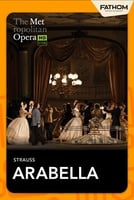Imagine Vienna at twilight—the chandeliers still shimmer, but the light has turned to amber. The...
Salome by Strauss — The Dance That Shook the World
 A Dangerous Desire
A Dangerous Desire
The first notes of Richard Strauss’s Salome don’t just begin—they strike. They shimmer with menace, like the glint of a blade before the deed. From its 1905 premiere, Salome was an explosion of decadence, psychology, and sound—a work that scandalized polite society and enthralled the modern one just coming into being. Strauss had taken a biblical tale, filtered through Oscar Wilde’s provocative play, and set it to music that made audiences blush, faint, or rise to their feet in ovation. It was as though opera had shed its corset, stood up from the parlor, and walked into the new century.
Wilde’s Words, Strauss’s Sound
Strauss was already known for his orchestral tone poems (Don Juan, Also sprach Zarathustra), but with Salome, he turned to opera with the confidence of a man ready to set the world aflame. The source—Wilde’s 1891 French play—had been banned in England for its blasphemous take on a biblical story. The opera tells of Princess Salome, who becomes obsessed with the imprisoned prophet Jokanaan (John the Baptist). When he rejects her advances, she demands his head—literally—as payment for her famous Dance of the Seven Veils.
What Strauss created was no standard morality tale. It was an erotic fever dream, rendered in orchestral Technicolor. The score’s chromatic harmonies pushed tonality to its limits, hovering between ecstasy and collapse. Listeners in 1905 were shocked: this was Wagnerian grandeur laced with the nervous energy of Freud’s Vienna and the decadence of Art Nouveau. It was also, for all its notoriety, an astonishing portrait of human obsession.
A Story of Obsession and Power
The plot unfolds in a single act, compressed like a psychological thriller. King Herod’s stepdaughter Salome, drawn to the mysterious voice of Jokanaan echoing from his cistern prison, insists on seeing him. When he’s brought up, she’s transfixed—not by holiness, but by hunger. Her advances grow more desperate, her language more fevered. When Jokanaan denounces her as a child of sin, she swears she will kiss his lips one day.
Herod, who himself lusts after Salome, offers her anything if she’ll dance for him. She obliges—with the now-legendary Dance of the Seven Veils—and then makes her demand: Jokanaan’s head on a silver platter. Herod recoils, but Salome is unrelenting. When the severed head is brought forth, she delivers her final kiss, triumphant and horrifying. Herod orders her death. A crash of orchestral dissonance ends the opera—the musical equivalent of a shattering mirror.
The Sound of Modernity
For all its shocking imagery, Salome is ultimately a masterpiece of structure and symphonic unity. Strauss’s massive orchestra—over 100 musicians—creates a world that swirls, seduces, and suffocates. Every motif seems to coil around Salome herself, binding her desire and doom into sound. The final monologue, where she sings to Jokanaan’s lifeless head, is one of opera’s most daring feats: a soprano pushed to extremes of both pitch and psychology, floating above an orchestra that seems to represent the madness of her mind.
For musicians and composers, Salome marked the beginning of something new. Mahler called it “a great and genius work.” Schoenberg called it “the gateway to modern music.” For the audience of 1905, it was a shock. For today’s listeners, it feels uncannily familiar—a portrait of a world obsessed with beauty, power, and the blurring of morality in the pursuit of desire.
Echoes in Today’s Mirror
More than a century later, Salome still unsettles—and that’s precisely why it endures. Its themes of voyeurism, celebrity, and self-obsession anticipate our social-media age, where image often outweighs substance and desire can consume judgment. Salome’s gaze, fixed so dangerously on Jokanaan, is the gaze of a culture that confuses attention with love.
When the Metropolitan Opera brought Salome back for audiences in The Met: Live in HD broadcast, it wasn’t nostalgia—it was recognition. Whether sung by Karita Mattila’s electrifying interpretation or Lise Davidsen’s upcoming portrayal, the role continues to test the limits of voice and vulnerability. The opera feels as modern as any film noir or psychological thriller, its music still blazing with moral heat.
Opera Insight
Did you know? The 1905 Dresden premiere of Salome was so scandalous that Kaiser Wilhelm II reportedly declared, “I regret that Strauss ever wrote it.” The composer, hearing of the comment, dryly replied, “I made my fortune from it.” (Proof that controversy sometimes pays—both artistically and financially.)
A Reflection That Still Burns
In the end, Salome is not just a story about lust or vengeance—it’s about the perilous desire to possess what must remain untouchable. Strauss transformed Wilde’s poetic decadence into sound that still feels dangerous, glittering, and alive. For all the outrage it caused, Salome opened the door for modern opera’s psychological realism, setting the stage for everything from Berg’s Lulu to Britten’s The Turn of the Screw.
Listening today, we hear ourselves in it—the tension between fascination and fear, beauty and ruin. And perhaps that’s the most modern thing of all: Strauss held up a mirror to our darkest impulses, and the reflection still stares back.
Friends of the Opera is dedicated to making opera accessible, educational, and inspiring for everyone in our community. If you enjoy reading the Friends of the Opera blog, including Arias and Insights, please consider signing up for a membership or providing a donation of support: Learn More



